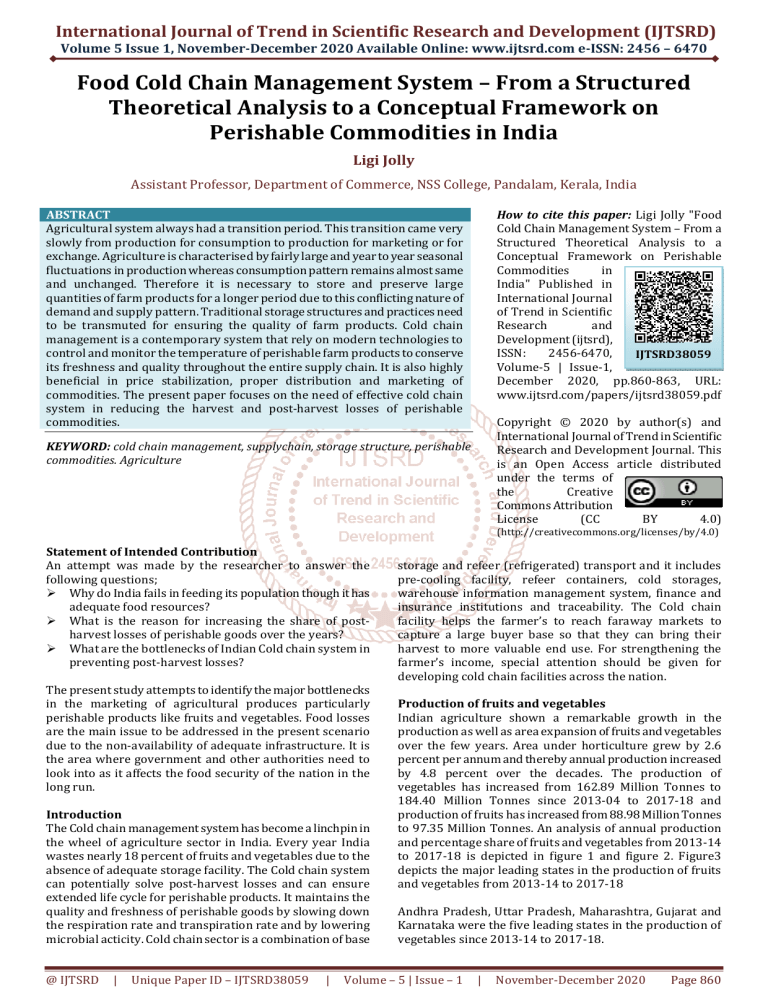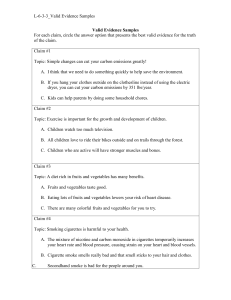
International Journal of Trend in Scientific Research and Development (IJTSRD)
Volume 5 Issue 1, November-December 2020 Available Online: www.ijtsrd.com e-ISSN: 2456 – 6470
Food Cold Chain Management System – From a Structured
Theoretical Analysis to a Conceptual Framework on
Perishable Commodities in India
Ligi Jolly
Assistant Professor, Department of Commerce, NSS College, Pandalam, Kerala, India
ABSTRACT
Agricultural system always had a transition period. This transition came very
slowly from production for consumption to production for marketing or for
exchange. Agriculture is characterised by fairly large and year to year seasonal
fluctuations in production whereas consumption pattern remains almost same
and unchanged. Therefore it is necessary to store and preserve large
quantities of farm products for a longer period due to this conflicting nature of
demand and supply pattern. Traditional storage structures and practices need
to be transmuted for ensuring the quality of farm products. Cold chain
management is a contemporary system that rely on modern technologies to
control and monitor the temperature of perishable farm products to conserve
its freshness and quality throughout the entire supply chain. It is also highly
beneficial in price stabilization, proper distribution and marketing of
commodities. The present paper focuses on the need of effective cold chain
system in reducing the harvest and post-harvest losses of perishable
commodities.
How to cite this paper: Ligi Jolly "Food
Cold Chain Management System – From a
Structured Theoretical Analysis to a
Conceptual Framework on Perishable
Commodities
in
India" Published in
International Journal
of Trend in Scientific
Research
and
Development (ijtsrd),
ISSN:
2456-6470,
IJTSRD38059
Volume-5 | Issue-1,
December 2020, pp.860-863, URL:
www.ijtsrd.com/papers/ijtsrd38059.pdf
Copyright © 2020 by author(s) and
International Journal of Trend in Scientific
Research and Development Journal. This
is an Open Access article distributed
under the terms of
the
Creative
Commons Attribution
License
(CC
BY
4.0)
KEYWORD: cold chain management, supplychain, storage structure, perishable
commodities. Agriculture
(http://creativecommons.org/licenses/by/4.0)
Statement of Intended Contribution
An attempt was made by the researcher to answer the
following questions;
Why do India fails in feeding its population though it has
adequate food resources?
What is the reason for increasing the share of postharvest losses of perishable goods over the years?
What are the bottlenecks of Indian Cold chain system in
preventing post-harvest losses?
The present study attempts to identify the major bottlenecks
in the marketing of agricultural produces particularly
perishable products like fruits and vegetables. Food losses
are the main issue to be addressed in the present scenario
due to the non-availability of adequate infrastructure. It is
the area where government and other authorities need to
look into as it affects the food security of the nation in the
long run.
Introduction
The Cold chain management system has become a linchpin in
the wheel of agriculture sector in India. Every year India
wastes nearly 18 percent of fruits and vegetables due to the
absence of adequate storage facility. The Cold chain system
can potentially solve post-harvest losses and can ensure
extended life cycle for perishable products. It maintains the
quality and freshness of perishable goods by slowing down
the respiration rate and transpiration rate and by lowering
microbial acticity. Cold chain sector is a combination of base
@ IJTSRD
|
Unique Paper ID – IJTSRD38059
|
storage and refeer (refrigerated) transport and it includes
pre-cooling facility, refeer containers, cold storages,
warehouse information management system, finance and
insurance institutions and traceability. The Cold chain
facility helps the farmer’s to reach faraway markets to
capture a large buyer base so that they can bring their
harvest to more valuable end use. For strengthening the
farmer’s income, special attention should be given for
developing cold chain facilities across the nation.
Production of fruits and vegetables
Indian agriculture shown a remarkable growth in the
production as well as area expansion of fruits and vegetables
over the few years. Area under horticulture grew by 2.6
percent per annum and thereby annual production increased
by 4.8 percent over the decades. The production of
vegetables has increased from 162.89 Million Tonnes to
184.40 Million Tonnes since 2013-04 to 2017-18 and
production of fruits has increased from 88.98 Million Tonnes
to 97.35 Million Tonnes. An analysis of annual production
and percentage share of fruits and vegetables from 2013-14
to 2017-18 is depicted in figure 1 and figure 2. Figure3
depicts the major leading states in the production of fruits
and vegetables from 2013-14 to 2017-18
Andhra Pradesh, Uttar Pradesh, Maharashtra, Gujarat and
Karnataka were the five leading states in the production of
vegetables since 2013-14 to 2017-18.
Volume – 5 | Issue – 1
|
November-December 2020
Page 860
International Journal of Trend in Scientific Research and Development (IJTSRD) @ www.ijtsrd.com eISSN: 2456-6470
Uttar Pradesh, West Bengal, Madhya Pradesh, Bihar and
Gujarat were the five leading states in the production of
fruits since 2013-14 to 2017-18.
Figure 1
Source: Ministry of Agriculture and Farmers Welfare
Figure 2
Source: Ministry Of Agriculture and Farmers Welfare
Figure 3
Source: Ministry of Agriculture and Farmers Welfare
Post-harvest losses of fruits and vegetables
India continues to fail in feeding its population, even though it has abundant agricultural resources. India ranked 103 among
119 countries as per Global Hunger Index. As per the latest report of FAO (United Nation’s Food and Agriculture Organization,
2019), India wastes nearly one lakh million worth of food every year and 40-50 percent of food gets spoiled before reaching the
neediest consumers. Every single day, close to 194 million people go hungry all over the country. India needs to feed nearly
225-230 million tonnes per year.
By taking into consideration, the growing need of preserving food for ensuring the food security of the nation, suitable
mechanism need to be developed for minimising the harvest and post-harvest losses of fruits and vegetables.
Harvest and post-harvest losses of major food grains are depicted in table 1
@ IJTSRD
|
Unique Paper ID – IJTSRD38059
|
Volume – 5 | Issue – 1
|
November-December 2020
Page 861
International Journal of Trend in Scientific Research and Development (IJTSRD) @ www.ijtsrd.com eISSN: 2456-6470
Crops
Apple
Banana
Citrus
Grape
Guava
Mango
Papaya
Sapota
Onion
Tomato
Cabbage
cauliflower
potato
Table 1
% Average loss (CIPHET Nanda etal2012) % Average loss (CIPHET Nanda etal2015)
12.3
10.39
6.6
7.76
6.4
9.69
8.3
8.63
18.01
15.88
12.7
9.16
7.36
6.7
5.8
9.73
7.5
8.20
13.0
12.44
6.9
9.37
6.9
9.56
9.0
7.32
Source: CIPHET Report, 2015
Ever year India wastes nearly 18 percent of fruits and vegetables due to lack of post harvesting storage mechanism. According
to MFPI (Ministry of Food Processing Industry), post-harvest losses of food grains are 25 million tonnes whereas fruits and
vegetables constitute 12 million tonnes and 21 million tonnes respectively.
Systems for post-harvest loss handling
Post-harvest management is one of the major intervention to improve the farm production by doubling the income of farmers.
India is lacking a sustainable supply chain management system due to its unorganised nature. Therefore, India needs an
effective cold chain system which will integrate the supply chain for vegetables and fruits from the post-harvesting stage to
ultimate consumption stage.
Cold chain system remains untapped due to several reasons like high initial investment for setting up, high share of single
commodity, lack of adequate basic infrastructure, lack of awareness for handling perishable goods or lapse of service either by
the storage provider or the transporter.
Table 2 depicts the Gap analysis of cold chain infrastructure in India
No
Infrastructure component
1
2
3
4
5
6
Pack-House
Cold Storage (Bulk)
Cold Storage(Hub)
Refeer Vehicle
Ripening Chamber
Onion storage structure
Table 2
All India Requirement(A)
Holding Capacity/
Numbers
Storage size
11,21,274MT
70,080
341,64,411MT
9,36,251MT
4,94,608MT
61,826
91,306MT
9,131
70,06,028MT
2,80,241
Source: NCCD, 2015
All India created(B)
Number/
storage capacity
249nos
All India Gap
31823700MT
(32,76,962)MT
(52,826)Nos.
(8,319)Nos.
-
812nos
-
(69,831)Nos.
Gap analysis indicates that Present capacity is nowhere close enough to support cold chain management system. A study
conducted by Indian institute of management, Kolkata has discovered that nearly 10 percent of agriculture produce get cold
storage facility in India.
Challenges in cold chain management system
Misallocation of cold storages
Majority of the cold storages are concentrated into few states
of the nation and rest are undeserved. As per the report of
Emerson (2013), 60 percent of India’s cold storage capacities
are utilised just by 4 states-West Bangal, Uttar Pradesh,
Gujarat and Punjab.High share of a single commodity pause a
problem for preserving other commodities.
Potato accounts for 75-80% of the storage capacity.
Under developed refeer transport
According to the report on Global capacity by international
Association of Refrigerated warehouse (2010), nearly 104
MT of perishable farm products are transported between the
@ IJTSRD
|
Unique Paper ID – IJTSRD38059
|
cities of the country every year. Out of which approximately
100 MT moves via non refeer (non-refrigerated) mode and
only 4 MT are transported by refeer mode.
Untrained handling of perishable products
In India, a warehouse with air condition is considered as a
cold storage. Different commodities require different
temperature handling mechanism, which may not be known
to the cold storage staff and those who handles the products
including transporters. It ultimately leads to inventory
losses.
Non-prioritization of vegetables
Most of the pack houses in India are mainly focused on fruits
and there is little emphasis for vegetable sector. Some of the
Volume – 5 | Issue – 1
|
November-December 2020
Page 862
International Journal of Trend in Scientific Research and Development (IJTSRD) @ www.ijtsrd.com eISSN: 2456-6470
exotic vegetables are handled properly and others are
outside the attention of pack houses.
High capital cost
Entrepreneurs my not find cold storage as a viable option for
investment as it require huge set-up cost. It was estimated
that approximately 3-4 Crores in Indian rupees is required
for setting up of 5000 MT cold storages and to set up a 1000
MT multi-purpose cold storage, investment of around 20
Crores are required.
Conclusion
India ranks first position in the production of Banana,
Mango, Lime, Lemon, papaya and Okra and it is a pride factor
that it is the second largest producer of vegetables and fruits.
Food wastage of fruits and vegetables are also in the range of
18-40 percent. Post harvesting management system in India
is still at its nascent stage. India needs an effective cold chain
system to reduce the harvest and post-harvest losses and to
provide an extended life cycle of perishable products. In
turn, it will ensure the food security of the nation. Effort
should be made from the Government to ensure the proper
functioning of the cold chain system where 100 percent FDI
is admitted in this sector. India needs to mobilise large scale
investment in cold storages, refrigerated transports and on
other logistics management systems.
REFERENCES
[1] Acharya SS and, Agarwal NL (2016), Agricultural
Marketing in India, 6th ed. Oxford and IBH Publishing,
New Delhi.
[2]
Mr. Karthikeyan, krishiJagran, 20 March, 2019,
retrieved
from
https://krishijagran.com/featured/better-food-withbetter-management-cold-chain-and-its-benefits-forfarmers/
@ IJTSRD
|
Unique Paper ID – IJTSRD38059
|
[3]
Agmarknet, Commodity wise distribution of cold
storages as on 31-12-2009,retrieved from
http://agriexchange.apeda.gov.in/Ready%20Reckone
r/Cold_Storage/COMMODITYWISEDISTRIBUTIONOF
COLDSTORAGES.aspx
[4]
NCCD Report,2015,www.nccd.gov.in
[5]
Jha, Shyam & Vishwakarma, Rajesh & Ahmad,
Tauqueer & Rai, Anil & Dixit, Anil. (2016). Assessment
of Quantitative Harvest and Post-Harvest Losses of
Major
Crops/Commodities
in
India.
www.researchgate.net/publication/289637983_Asse
ssment_of_Quantitative_Harvest_and_PostHarvest_Losses_of_Major_CropsCommodities_in_India
[6]
Horticulture at glance,2015 published by ministry of
Agriculture
and
Farmers’
welfare,
http://nhb.gov.in/PDFViwer.aspx?enc=3ZOO8K5Czcd
C/Yq6HcdIxMvJ0RY/w0FTznMeREnr5ok=
[7]
Horticulture at glance,2016 published by ministry of
Agriculture
and
Farmers’
welfare,
http://nhb.gov.in/PDFViwer.aspx?enc=3ZOO8K5Czcd
C/Yq6HcdIxMvJ0RY/w0FTznMeREnr5ok=
[8]
Horticulture at glance,2017 published by ministry of
Agriculture
and
Farmers’
welfare,
http://nhb.gov.in/PDFViwer.aspx?enc=3ZOO8K5Czcd
C/Yq6HcdIxMvJ0RY/w0FTznMeREnr5ok=
[9]
Horticulture at glance, 2018 published by ministry of
Agriculture
and
Farmers’
welfare.
http://nhb.gov.in/PDFViwer.aspx?enc=3ZOO8K5Czcd
C/Yq6HcdIxMvJ0RY/w0FTznMeREnr5ok=
[10]
CIPHET
Report
https://www.ciphet.in/annualreports.php
[11]
http://agriculture.gov.in/Agriculture_Situations.aspx
Volume – 5 | Issue – 1
|
November-December 2020
2015,
Page 863




